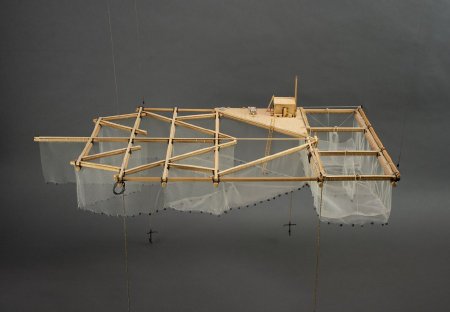Description:
Heckman Patents First Floating Fish Trap
While efficient and popular, use of standing or pile traps at the mouths of salmon spawning streams was prohibited in 1906 because they caught nearly every fish entering the stream, endangering profitable salmon runs. Trap operators and canneries responded by building traps along salmon migration routes, which were often too deep to drive the pilings.
In 1907, J.R. Heckman of the Alaska Packers Association anchored a prototype of his newly developed fish trap off Point Higgins after it was constructed and towed from Loring. The floating fish trap could be used in deeper water, held stationary by anchors rather than pilings. The trap's first season catches were estimated at 500,000 to 750,000. Heckman moved forward on his venture and eventually patented the "floater" in 1908.
This month's featured artifact is a scale model by Mark Hutson of a typical Southeast Alaska floating fish trap. Migrating salmon entered the trap at the viewer's left, passing through a "jigger" (first section) and the "heart" (second section) to become trapped in the "pot" (center section at right). Trapped fish were let into the "spiller" sections on the viewer's right side, where they were brailed into scows for delivery to the cannery.
At the end of each season, it was required that traps be removed from their locations, which was costly for standing traps. Floating traps could simply be towed back to town or to a sheltered cove. Floating traps quickly replaced standing traps, and their efficiency and low cost caused a production boom for the salmon industry as well as the logging industry. The State of Alaska banned fish traps in 1959.
Object ID #: KM 2007.2.5.1

